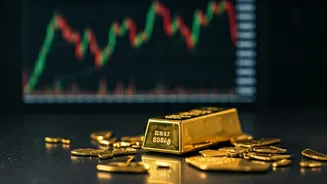The Recent Plunge
Gold prices recently experienced a substantial drop, plummeting to around $4,000. This dramatic decline marked the most significant fall in the gold market
over the past 12 years. This downturn has captured the attention of investors and analysts alike, prompting discussions about the underlying causes and potential implications for the future of gold as an investment. The speed and scale of the price decrease have led to significant volatility, creating both opportunities and risks for those involved in the gold market.
Factors Behind the Fall
Several factors contributed to the recent decrease in gold prices. Economic indicators, such as shifts in interest rates and inflation figures, played a crucial role. Rising interest rates can make gold less attractive as an investment because it doesn't offer any yield like bonds. Conversely, the strength of the U.S. dollar often has an inverse relationship with gold prices; a stronger dollar can make gold more expensive for buyers holding other currencies, reducing demand. Market sentiment and speculative trading also influenced the price fluctuations. These combined elements created a perfect storm, pushing the price of gold downwards.
Market Forecasts Examined
The future trajectory of gold prices remains uncertain, with various market forecasts offering differing perspectives. Some analysts believe that the current decline is a temporary correction, suggesting a potential rebound in the coming months. They base this optimistic outlook on factors like continued geopolitical instability and potential inflationary pressures. Other experts are more cautious, anticipating further price declines due to persistent economic challenges and anticipated shifts in monetary policy. These analysts highlight the possibility of continued downward pressure on gold prices if the dollar strengthens further or if interest rates rise. The market’s reaction will depend heavily on upcoming economic data releases and unexpected global events.
Impact on Investors
The price drop significantly affected investors involved in the gold market. Those who held gold as part of their portfolio saw a reduction in the value of their holdings. This has prompted many investors to re-evaluate their positions, with some deciding to sell their gold to cut losses. The decrease has also presented a chance for those looking to buy, as the lower prices make gold more accessible. However, it is essential to consider the risks involved, as prices can still fluctuate. Investors need to assess their risk tolerance and investment goals to make informed decisions about their gold investments during this volatile period.
Looking Ahead
The future of gold prices hinges on numerous factors. The direction of the global economy, including inflation rates and monetary policy decisions, will be critical. Geopolitical events, such as international conflicts and trade tensions, may also influence investor sentiment and gold demand. The strength of the U.S. dollar is another crucial factor. Gold’s performance also depends on investor confidence and shifts in market expectations. Those invested in gold must monitor these factors closely to make informed choices. The market's unpredictable nature means that continuous adaptation and careful evaluation are vital for navigating the dynamic world of gold investments.














